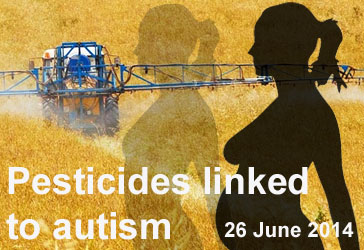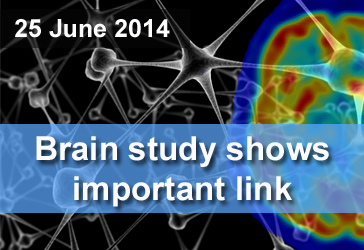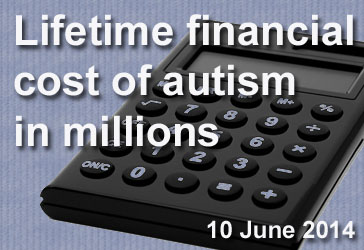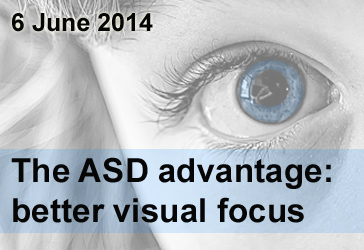Archives
June, 2014
Select a different month in the archive
Pesticide Exposure Linked to Increased Risk of Autism
By Shana R. Spindler, Ph.D. on June 26, 2014

Background: Past studies have generated concerns regarding pesticide exposure during pregnancy and developmental delays in the child. But what role does pesticide exposure have, if any, in autism?
News Brief: Exposure to certain types of agricultural pesticides during or slightly before pregnancy may increase a woman’s risk of having a child with autism, according to a study published this month by University of California researchers. The team of scientists followed 970 participants as part of the Childhood Autism Risks from Genetics and Environment (CHARGE) Study. The researchers compared commercial pesticide application data with the addresses of study participants and found that those living near the application of organophosphates, a type of pesticide that affects how neurons function, were 60 percent more likely to have a child diagnosed with autism. Study participants living near the use of pyrethoid insecticides, a common type of insecticide that also affects insect nerve cells, showed increased risk for both autism and developmental delay.
Why it's important: It is important to recognize that this study shows correlation, not causation. The increased risk of autism in children whose mothers reside near pesticide application may or may not be due to the pesticides themselves, but other factors that are common in families who live near agricultural sites. Certainly, the study supports a closer examination of pesticide exposure and the ballooning rates of autism diagnosis.
Help me understand :
| Source(s) : |
| Tweet |
Link Between Oxytocin And Serotonin May Inform Therapy
By Wayne Pereanu, PhD on June 25, 2014

Background: Previous work has shown that some individuals with Autism Spectrum Disorder (ASD) have altered levels of oxytocin and serotonin, chemical messengers in the brain that regulate human emotion and behavior. Recent work in animal models has suggested that oxytocin influences the amount of serotonin produced. While this work in animals is suggestive, there have been no comparable studies in humans.
What's New: In the June 2014 issue of the Proceedings of the National Academy of Sciences, researchers report that oxytocin regulates the level of serotonin in the brains of neurotypical individuals. The researchers administered oxytocin through the nose in half of the participants (the other half got a placebo). The group then injected study participants with a tracer compound that allows researchers to infer levels of serotonin in the participants’ brains using PET, a type of specialized brain scan. The team found that oxytocin application induced a decrease in the amount of serotonin in four brain areas that are thought to be important for emotion-based behavior.
Why it's important: Drugs that alter levels of either oxytocin or serotonin are currently used to treat various ASD-associated symptoms. This study is the first to show that oxytocin levels can decrease the amount of serotonin in human brains. While this supports previous animal studies, it is an important and requisite step to show this in humans. Their findings suggest that treatment of oxytocin and serotonin levels should be coordinated.
Help me understand :
| Source(s) : |
| Tweet |
Lifetime Financial Cost of Autism in Millions
By Shana R. Spindler, Ph.D. on June 10, 2014

Background: The financial cost associated with autism therapy, lost time at work, and medical bills are significant. One study quantified this cost.
What's new: The lifetime cost of supporting someone with Autism Spectrum Disorder (ASD) ranges from 1.4 to over 2 million dollars, according to a new study by United States and United Kingdom researchers. The team reviewed online research literature using keywords associated with autism and financial costs. Special education programs and parental productivity loss contributed the most to cost during childhood, while supported living accommodations and individual productivity loss contributed to high costs during adulthood.
Why it's important: The study highlights the critical need for cost-effective interventions and policies that take into account the financial impact of ASD on families.
Help me understand :
| Source(s) : |
| Tweet |
Children with ASD Have Greater Visual Focus
By Chelsea E. Toledo, M.A. on June 6, 2014

Background: Autism Spectrum Disorder (ASD) is characterized by atypical communication, social skills, and behaviors. While much research has focused on deficits in speech and social learning, few studies have focused on areas where children with ASD outperform their peers—namely, in the performance of many visual tasks requiring sustained attention.
What’s New: On March 7, 2014, the journal Scientific Reports published a study comparing the visual capabilities of autistic children and their typically developing peers. The researchers—who had previously shown that toddlers with ASD scored better on visual search tasks—measured pupil dilation in 34 children between the ages of one and three years as they viewed pictures and animations containing a distinct target. For example, the children were encouraged to locate a red apple in an image that also contained blue apples and other red shapes. Pupil dilation in the 17 children with ASD indicated that, while they searched similarly to their peers, their focus was much more intense.
Why it’s important: For the first time, pupillometry, a sensitive measure of task-based pupil responses, is used to evaluate superior visual performance in children with ASD compared to typically developing controls.The differences observed in the two groups indicate different activity levels of the locus coeruleus-norepinephrine (LC-NE) system, part of the brain underlying the regulation of attention. This study lends support to the idea that individuals with ASD could perform better on tasks requiring undistracted focus compared to tasks requiring rapid shifts in attention.
Help me understand :
| Source(s) : |
| Tweet |

